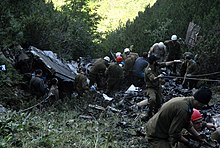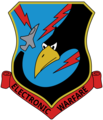|
Tel Nof Airbase
 Tel Nof Airbase (Hebrew: בָּסִיס חֵיל-הַאֲוִויר תֵּל נוֹף, English: Lookout hill) (ICAO: LLEK), also known as Air Force Base 8, is the oldest and main base of the Israeli Air Force (IAF) located 5 km south of Rehovot, Israel. Tel Nof houses two strike fighter, two helicopter and a UAV squadron. Also located on the base are the Flight Test Center Manat and several special units of the Israel Defense Forces (IDF), among others Unit 669 (heliborne Combat Search and Rescue, CSAR) and the Paratroopers Brigade training center and its headquarters.[1] HistoryBritish MandateEstablished in July 1939 as RAF Aqir during the British Mandate, it served as the main base for the Royal Air Force (RAF) in Palestine. It was named after the Palestinian village Aqir north of it that perished in the 1948 Palestine war and was located in the area of today's Kiryat Ekron. Operational units from 1941 to 1948
Gallery
Names of the baseAfter the British withdrawal from RAF Aqir in May 1948, the base was renamed Ekron Airbase – after the biblical city of Ekron and today's Kiryat Ekron 1 km north of it – and, from 1950, Tel Nof Airbase (English: Lookout hill). The name "Tel Nof" dates back to the 1930s, when the area was known by this name as an urban development area, similar to the then-thriving "Tel Aviv" (English: Spring hill). First Israeli fighter aircraftOn 29 May 1948, the first four fighter aircraft Avia S-199 of the first aircraft squadron 101 "First Fighter" of the Israeli Air Force (IAF) took off from here for their first mission, an attack on the Ad Halom Bridge in the eastern outskirts of Ashdod, which was in the hands of Egyptian troops, who advanced on Tel Aviv. Important was less the modest military success of this operation – one plane was shot down – than the shock to the Egyptian soldiers when they saw with their own eyes that Israel now had an Air Force (see photo of plaque in gallery below). The advance was delayed, and this gave the Israeli army (IDF) enough time to bring in troops and stop it. On 17 August 1948, Ekron Airbase (later Tel Nof Airbase) was officially and ceremoniously opened. Hatzor Airbase and Ramat David Airbase taken over from the British soon followed. After the Avia S-199 – imported from Czechoslovakia and a replica of the Messerschmitt Bf 109 made out of parts left over from German war production – additional fighter aircraft were acquired from the stocks of the former Allies, such as the British Supermarine Spitfire and the North American P-51 Mustang. The IAF Flight Academy, which was initially based at Camp Sirkin east of Petah Tikva, was established at Tel Nof in 1955 until it was relocated to the then newly built Hatzerim Airbase in 1966, where it still is today.[6]
First cargo aircraftAt the beginning of the Palestine War in late 1947, ten Curtiss C-46 Commando cargo aircraft were purchased from the US Air Force inventory and eventually stationed at Ekron Airbase. They formed the backbone of the transport fleet of the newly founded Israeli Air Force and were consolidated in December 1948 with the formation of the 106 Squadron "Spearhead". During the war, these aircraft transported equipment and supplies to the troops and settlers in the Negev Desert in southern Israel and also carried out occasional bombing raids. Important landing sites for supply flights were the Ruhama Airfield east of Sderot (see photo in gallery below) and the Malhata Airfield east of Beersheba, today's Nevatim Airbase.[7] In March 1949, shortly before the end of the war, the cargo aircraft also took part in Operation Uvda, the securing of the southern Negev up to the Red Sea, as envisaged by the UN partition plan of 1947. For this purpose, the temporary Abraham Airfield (Sde Avraham) was built far to the south, near today's Ovda Airbase. After the Palestine War, the aircraft were then used by El Al Israel Airlines (see photo in gallery below) or transferred to the 103 Squadron "Elephants". The 106 Squadron "Spearhead" was then shut down again and only reopened in June 1982 with F-15C/D jets on Tel Nof.[8]
Paratroopers BrigadeDuring the 1948 Palestine War there was a provisional paratroopers unit in Israel, which was expanded from the beginning of the 1950s into a regular Paratroopers Brigade, whose headquarters and training center is still located at Tel Nof to this day. This brigade and its units has since been involved in many important operations in Israel's wars, such as: the Suez Crisis and the Six-Day War, where the conquest of the Old City of Jerusalem with the capture of the Temple Mount and the Western Wall by Israeli paratroopers was particularly remembered.
One and a half kilometers west of Tel Nof lies the main Paratroopers Memorial near National Road
Six-Day WarAs late as the Six-Day War in June 1967, French fighter jets manufactured by Dassault Aviation played a leading role in the IAF, such as the Mystère IV, the Super Mystère and the Mirage III. Some of these were also stationed at Tel Nof at that time. In the mid-1960s, Israel had commissioned Dassault to build an improved version of the Mirage III that was specifically tailored to the needs of the IAF, as they needed a ground attack aircraft in a desert environment. The first examples of this version, called the Mirage 5, were supposed to be delivered in 1967, but this never happened. The French-built fighter jets – except the Mirage 5 – now on display at the IAF Museum near Hatzerim Airbase:
In response to the Six-Day War, the delivery of 50 already produced and largely paid for Dassault Mirage 5 to Israel was stopped by French President Charles de Gaulle, as he no longer wanted to supply new offensive weapons to the former ally. After Israeli commando units blew up 14 Lebanese airliners at Beirut Airport on the evening of 28 December 1968 in Operation Gift, using French transport helicopters Super Frelon from Tel Nof and naval boats supplied by France, de Gaulle then imposed a total arms embargo on Israel.[9][10] Yom Kippur War Despite the French arms embargo Tel Nof Airbase had been steadily expanded over the years, and during the Yom Kippur War in October 1973, seven air squadrons operated at the base. While the Six-Day War 1967 was still characterized by French-made fighter aircraft, US ones now dominate. The seven squadrons at Tel Nof during the Yom Kippur War:
US-made airplanes, most of them now at the IAF Museum near Hatzerim Airbase:
The total of twelve (or sixteen) Super Frelon Tzirʿa transport helicopters that Israel had received from France before the embargo were stationed in the 114 Squadron "Night Leaders" at Tel Nof from 1966 to 1991 and were retrofitted with more powerful US engines until they were finally all decommissioned.[15] The more than twenty French but German-built and delivered Nord Noratlas transport aircraft of the 103 Squadron "Elephants" at Tel Nof were in service there from 1956 to 1978. Most of them were former machines of the German Air Force (Deutsche Luftwaffe) or were built under license in Germany and handed over or delivered to Israel from the early 1960s.[17]
F-15 Fighter JetsArrival of the F-15 From 1976, the then new F-15A/B Eagle Baz fighter jets were introduced with 133 Squadron "Knights Of The Twin Tail", which made Israel the first country in the world outside the United States to possess this aircraft. Because the landing of the first three planes was delayed on that Friday, 10 December 1976, the reception ceremony was also delayed and only ended shortly before the beginning of Shabbat. As a result, some government ministers didn't have enough time to return home before the start of Shabbat. Its "desecration" led to a government crisis and ultimately to the collapse of the coalition of the first government of Yitzhak Rabin.[18] Not long after receiving the first F-15 aircraft, Israel began to upgrade and convert these jets, which were originally built for air combat only, for use against ground targets also. This was done with both the single-seat A and C variants, as well as the two-seat B and D trainer versions, where the flight instructor's seat was converted to that of the navigator (Israeli designation) or WSO (see photo of converted F-15C/D jets to the right above). In June 1982, with the reopening of the 106 Squadron "Spearhead", a second squadron of improved F-15C/D Baz fighter jets was introduced at Tel Nof.[7] Both F-15 squadrons still exist today, and from 2029 they will receive the latest variant F-15IA (Israel Advanced), which is based on the F-15EX Eagle II of the US Air Force (see photo of an F-15EX in gallery below).[19] Nuclear weaponsIt is assumed (e.g. by the Bulletin of the Atomic Scientists) that Israel is in possession of nuclear weapons since the late 1960s and that they are stored at some point at Tel Nof in a specially secured area (presumably here: 31°50′52″N 34°48′53″E / 31.847892°N 34.814606°E) and at the neighboring Sdot Micha Airbase in bunkers (presumably here: 31°45′21″N 34°55′03″E / 31.755783°N 34.917572°E) near the positions of Jericho missiles.[20][21][22][23] Strike fighter jets that can carry such weapons over long distances, such as the F-15 Eagle today (see gallery below) and the F-4E Phantom II (see picture above), have been on alert at the base around the clock since 1970, when the first F-4E fighter jets were stationed there in the 119 Squadron "Bat".[11] This form of deterrence was one of the lessons that Israel learned from the wars with its neighbors, even though the country has not yet admitted that it has nuclear weapons. Operation Wooden LegOn 1 October 1985, under the name Operation Wooden Leg, ten two-seat F-15B/D Eagle Baz from Tel Nof (two of them in reserve) attacked the headquarters of the PLO near Tunis. On their 2,300 km long flight to the destination on the Mediterranean coast of Tunisia the F-15s were refueled several times by two Boeing 707 Re'em. The headquarters were completely destroyed and – depending on the source – 50 to 75 PLO fighters were killed, including many leaders, but not Palestinian leader Yasser Arafat. The action was condemned without dissent in the UNO, and the USA also criticized it because it strained its relationship with Tunisia. The eight F-15 jets from Tel Nof involved received a corresponding symbol (target cross in the red circle with a blue wooden leg, see picture in the gallery below).[24] F-15 variants at Tel Nof
TodayToday (2025), Tel Nof is home to two strike fighter jet and two transport helicopter squadrons as well as a drone squadron. Also located there is the Flight Test Center Manat with one example of all aircraft variants (see F-15I Eagle Ra'am in the gallery above and F-35I Adir in the gallery under "Units"). Several special units of the Israel Defense Forces (IDF) are also located there, including Unit 669 heliborne Combat Search and Rescue (CSAR) and the training center for the Israeli Paratroopers Brigade.
Units
Note: IAF aircraft can usually be assigned to their squadron by the symbols on the tail Accidents


See alsoReferences
Bibliography
External linksWikimedia Commons has media related to Tel Nof IAF base.
|
||||||||||||||||||||||||||||||||||||||||||||||





























































